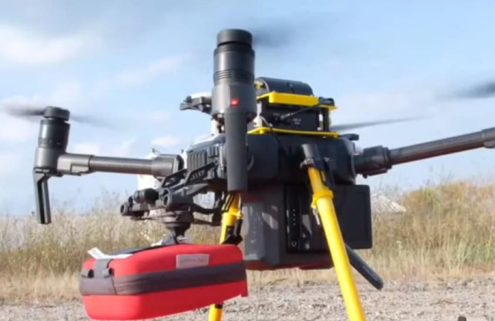Deploying Drones in Healthcare to Save Lives
The deployment of drones today has so far been limited to consumer markets. Yet that could soon be about to change thanks to advancements in cellular technologies, meaning we could soon see drones deployed increasingly across mission-critical and industry applications.
This could change everything. For example, cellular-connected drones could be deployed for automated inspection of critical infrastructure such as roads/highways, bridges, buildings, power stations, nuclear reactors, electrical grids, power dams, railways, pipelines and cell towers. Most of these inspection processes are currently done by humans, which makes them slow, costly and often dangerous.
Another use case, which could have a profound impact on our lives, is the deployment of drones in mission-critical healthcare applications.
Deploying Drones in Healthcare
When someone experiences cardiac arrest, getting treatment fast is essential. The probability of survival declines by 10 percent with every minute that passes.
Reaching patients in time is hard enough in cities that have highways and hospitals within reach. Getting life-saving equipment and medical assistance quickly to the far-flung citizens is a real challenge.
Drones are being used in healthcare to deliver automated external defibrillators (AEDs) and medications to remote locations for a while, but those traditional drones were limited to line-of-sight control, guided by an on-site operator.
What if, instead of a patient in distress (or worse), emergency medical service (EMS) paramedics could arrive at an emergency to find a patient in a more stable condition, because lifesaving equipment got to the scene while they were in transit?
The Winner? The patient.
A trial in this regard, has been conducted in Canada pitting EMS ambulances on the ground against drones equipped with automated external defibrillators (AEDs) using NetCloud Service, including an on-board, ruggedized Internet of Things (IoT) router and 4G LTE advanced connectivity. The results of the trial were extremely encouraging. During each test run, the drone arrived at least seven to fifteen minutes before the paramedic vehicles. Translated to an actual cardiac arrest, the extra time provided by the drones would greatly improve the patient’s chances for survival in the remote areas.
Flying Further and Doing More through LTE
In a very critical way, 4G LTE was the enabling technology in the trial. Previous drone trials relied on non-cellular technology, which limits them to trips shorter than five miles. By utilizing the LTE cellular network already in place, the drones in the trial were able to reach patients as far as 80 miles (128 kilometres) away.
When ultimately deployed, drones would be able to fly wherever there is cellular service, potentially covering distances as far as 80 miles away to deliver naloxone kits, EpiPens, emergency medications, defibrillator machines and even personal floating devices (PFD) in different emergency response situations.
But that’s not all. The speed, bandwidth and reliability of the LTE cellular network enables the drones to share images and video with operators and employ artificial intelligence (AI) to manage key functions such as collision avoidance. And the pilots could work safely from a facility anywhere in the world, with many resources at hand that would be unavailable out in the field.
5G will Unlock Amazing Potential for Good
Moving to cellular was a big leap because a drone is not just about transporting physical items. It’s also a vehicle for data acquisition. As we move towards 5G cellular, we’ll have a much larger pipe with much lower latency for collecting, computing and acting on more data, faster. Using ultra-high-resolution video, high-resolution sensors (lidar, spectrum analysis, x-rays, etc.) with AI, machine-learning (ML) and analytics, we’ll be able to have drones in many complex missions. The high-speed cellular data connection allows us to use the drone as a flying data acquisitions platform for numerous inspection applications employing different kinds of sensors that feed into AI/ML systems. Drones equipped with advanced sensors can perform extremely accurate inspection, saving a digital record of every inspection. We could detect the smallest changes that indicate a dangerous problem and trigger preventative action early on. And we’ll be able to conduct these inspections much more frequently and at a much lower cost.
Instead of individual drones controlled by a pilot onsite, there will be groups of drones, operated by a pilot hundreds of miles away over the cellular connection, that communicate and collaborate with one another to complete a task. Based on the data the drones gather, AI/ML systems can provide real-time analysis of critical situations and help people make higher quality decisions to keep our critical infrastructure operating well—and us all safe.



